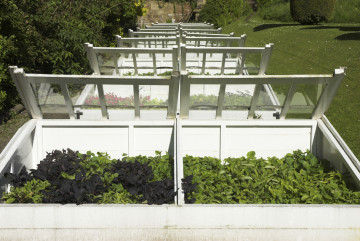Leonard Moorehead, the Urban Gardener A Mere Thaw?
Saturday, February 18, 2017
Low slung Mercury, diamond Venus, and crescent moon are best viewed just before dawn arrives a few minutes later. Wild fluctuations in temperature, howling northern gales, snowstorms and rain buffet garden and gardener. Would we have it any other way?
There is precious window space for those who yield to African Violets, Cyclamen or replaced the faded Amaryllis with a Phalaenopsis orchid. Perhaps you’ve kept a rose scented geranium past the winter doldrums? Fresh green rose scented leaves are redolent of June to come. Each of these blooming indoor plants manage to endure Saharan dry heating for weeks with a little TLC. Just beyond the glass the cold grips the garden, we have green leaves, vibrant bloom and loving scent alive in the home.
Always water each potted plant with tepid water, a plastic gallon jug under the counter is kept full and ready. Keep saucers under pots to collect any overflow water. Associate indoor gardening with a daily activity, such as finishing up after supper. Call for peace. Pour water as closely as possible to the area beneath growth. Quickly dab of any water pooled on African violet leaves with a paper towel or soft dishcloth. Orchids will live for years, especially the Phalaenopsis if kept to a dry regimen of 6 tablespoons of water a week. Beloved begonias are superb for the windowsill and bright rooms. Their tolerance for neglect is matched only by their vigorous survival. Longer days are prompting cane begonias to enter spring bloom, others display new growth. Each slowly unfurls in peaceful homage to sun and water.
GET THE LATEST BREAKING NEWS HERE -- SIGN UP FOR GOLOCAL FREE DAILY EBLASTDemonstrate watering to others. Ask them to cover for you if you escape away for more than a few days. Leave water ready for them, make it as easy as possible. Never burden a joy with obligation.
Force narcissi bulbs in stony forcing bowls. Keep moist at all times for good results. A simple cluster of 5 or 7 started now are happy harbingers of spring. Or trim a few branches from forsythia, place in a large water filled vase and enjoy golden yellow flowers during late winter snow storms. Dig in leftover bulbs into the garden, virtually all the paper white narcissi around many doorsteps are descended from forced bulbs. They naturalize in sunny loam.
Our innate desire to care and nurture has wide scope. A potted plant is hardly a small token, each plant is a world. Soon the outdoors will draw many of us away from windows. A cold frame in the garden plot will come into its own. The inexorable solar ascension melts away frost and snow, beneath thick mulches is much life. Witch Hazel teases us and Hellebore or the Lenten Rose are in the wings. Cold frames capture heat very effectively.
Cold frames are simple arrangements easily assembled from common debris in our cities or inexpensive lumber and plastic. The chance to be creative with cold frames is vast. All serve to warm garden soil and shield from dry cold wind. Often temporary, cold frames are useful far into the spring. Re-purposed dunnage in the garden covered with low covers has become snow free and frost free. Kale, broccoli, Kohlrabi, Swiss chard, beets in all of their shapes and colors, arugula, mustard, and endive are good candidates for the cold frame.
Cool late winter and early spring crops are plentiful for Zone 6 gardeners. Plan locations in advance, avoid walking anywhere on cultivated soil despite the protection of thick winter mulches, now much shrunken and advanced in their slow transition into humus. Gardeners are naturally vigilant, all bend to coax free the first sprigs of spring bulbs. Please, don’t trample snowdrops or crocus. Keep off the tulips.
Pull back mulches to the soil level for cold frames, lay the supports onto the soil, and gently cultivate the planting bed within. Frost never made it through to many mulched soils, especially in the sunniest areas. Soils high in organic materials absorb enormous amounts of moisture and support vibrant micro-organic ecosystems. Plainly labeled home- made seed strips are easy to make or purchase. Layout or sow the seeds closely, bury with a shallow amount of the soil and close the cold frame. Mound the pulled back mulch around the cold frame’s perimeter as a buffer against windy cold air. Establish a common direct route convenient for yourself and keep to it.
Our goal while in the garden is preserve as much as possible the soil’s friability and tilth. Raised beds preclude heavy footsteps in the garden. Avoid stepping on soggy winter soil. If you find short cuts, pave or mark out a path, it’s much easier to accept customary foot traffic than to discourage it.
Few garden tasks are more enjoyable than cultivating un-compacted soils with the fingers. Un-compacted soils open the thin humus mantle that supports life. Air, water, and heat nourish fungi and allow earth worms’ free passage. Nutrients are released as last year’s leaves become this year’s soil. Over time constant mulches actually raise the soil level, our corner carbon trap. Soils full of compost are free of sharp objects. Fingers connect us to the soil, breath and feel our connection between earth and sky. We are never alone.
Each sunrise is earlier, our sunsets postponed. Bird song greets mornings, snowdrifts retreat. Breath deep, we sense the advent don’t abandon the long johns just yet, keep the rubber soled shoes by the door. Keep the snow shovels handy. The cosmic kaleidoscope of Mercury, Venus, Moon, Mars and all the cherubim of heaven daily refocus. Gardeners are simply a humble part of the galactic whirl.
Leonard Moorehead is a life- long gardener. He practices organic-bio/dynamic gardening techniques in a side lot surrounded by city neighborhoods in Providence, RI. His adventures in composting, wood chips, manure, seaweed, hay and enormous amounts of leaves are minor distractions to the joy of cultivating the soil with flowers, herbs, vegetables, berries, and dwarf fruit tree.
Related Articles
- Leonard Moorehead, the Urban Gardener: Mums the Word
- Leonard Moorehead, the Urban Gardener: Glorious Asters Star
- Leonard Moorehead, The Urban Gardener: Frost Bites
- Leonard Moorehead,The Urban Gardener: Minor Bulbs Rule
- Leonard Moorehead, the Urban Gardener: Leaf Harvests
- Leonard Moorehead, The Urban Gardener: Infinity Beckons
- Leonard Moorehead, The Urban Gardener: The Fragrant Garden - Herbs for All
- Leonard Moorehead, The Urban Gardener: Harvesting Green Beans + Sunflowers
- Leonard Moorehead, The Urban Gardener: A World in a Drop of Water
- Leonard Moorehead, the Urban Gardener: Some Like it Hot
- Leonard Moorehead, The Urban Gardener: Celebrate the Fall Equinox
- Leonard Moorehead, the Urban Gardener: Stormy Horizons
- Leonard Moorehead, the Urban Gardener: Garden Gratitude
- Leonard Moorehead, The Urban Gardener: Winter Blooms
- Leonard Moorehead, the Urban Gardener: From Acorns Mighty Oaks Grow
- Leonard Moorehead, the Urban Gardener: Snug and Warm
- Leonard Moorehead, the Urban Gardener: Darkest Before the Dawn
- Leonard Moorehead, the Urban Gardener: Dreams Come True
- Leonard Moorehead, the Urban Gardener: Bless the Resolute
- Leonard Moorehead, the Urban Gardener: Hallelujah, the Leek
- Leonard Moorehead, the Urban Gardener: Garden Size Love Handles
- Leonard Moorehead the Urban Gardener: “Scent, First and Last”
- Leonard Moorehead, the Urban Gardener: Holly Saves Us
- Leonard Moorehead, the Urban Gardener: Winter Solstice
- Leonard Moorehead, the Urban Gardener: My Love is Like a Red, Red, Rose




